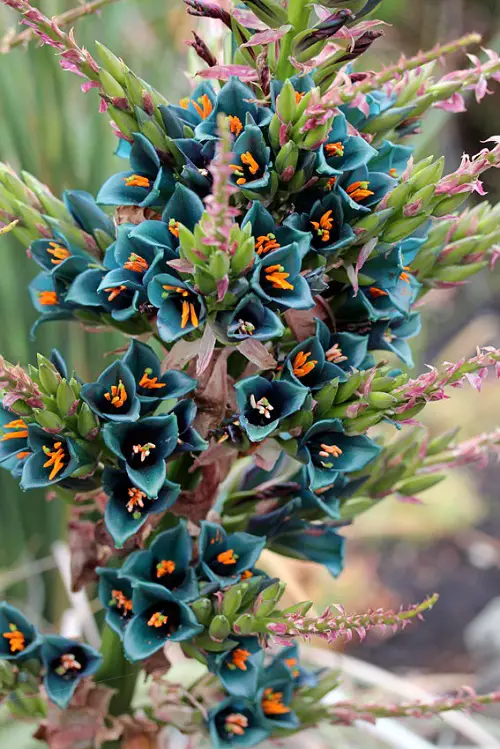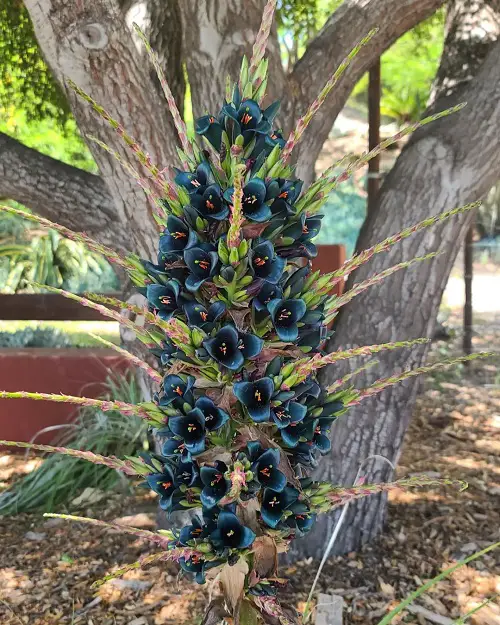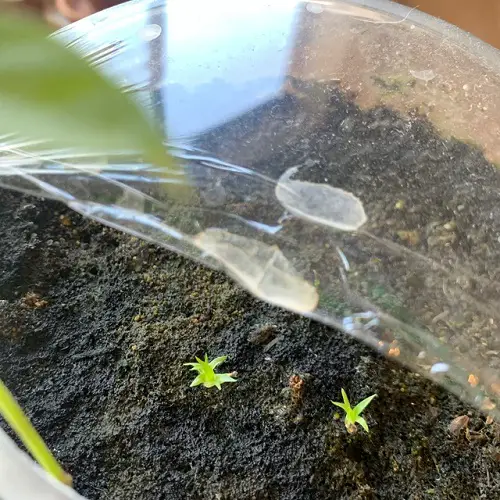Puya Alpestris Sapphire Tower is one of the most beautiful flowers you can grow in the garden! Here are all the details!

With its towering spikes of vibrant blue flowers, this plant makes a dramatic statement in any garden or indoor space. Let’s have a detailed look at the Puya Alpestris Sapphire Tower care.
Read about Ficus Umbellata Care
Puya Alpestris Sapphire Tower Plant Information
Puya is a large genus of bromeliads, popular for its impressive size and diversity, with around 199 species. One notable species, Puya ramondii, holds the title of being the largest bromeliad in the world, reaching up to 25-30 feet in height and 7-8 feet in width.
These plants are famous for their resilience and can withstand harsh conditions due to their natural habitat in the high elevations of the Andes Mountains in South America, where the climate is dry and temperatures can drop below freezing.
Puya Alpestris Sapphire Tower is a striking species featuring tall, upright stems covered with sharp, blue-green leaves that form a dense rosette. In summer, it produces stunning blue flowers that attract pollinators.
This hardy plant is adapted to high elevations in the Andes Mountains and makes a unique and eye-catching addition to any garden or landscape. Its exotic appearance and resilience to challenging conditions make it a popular choice among plant enthusiasts.
Propagating Puya Alpestris Sapphire Tower
You can grow Puya Alpestris Sapphire Tower by seed, division, and by cuttings.
- For propagation by seed, collect the ripe seed capsules of the Puya Alpestris Sapphire Tower and sow them in a well-drained soil mix. Keep the soil moist and place the pot in a warm, sunny location. The seedlings can be transplanted once they have at least three leaves.
- For propagation by division, carefully remove the Puya Alpestris Sapphire Tower from the pot and divide the root clump into smaller pieces. Replant each piece in a fresh pot and water thoroughly.
- Finally, for propagation by cuttings, take stem cuttings in the spring. Remove the leaves from the lower half of the cutting and dip the end in the rooting hormone. Plant the cutting in a pot filled with moist, well-drained soil mix and place it in a warm, sunny spot. Once the cutting has taken root, it can be transplanted into its own pot.
Requirements for Growing Puya Alpestris Sapphire Tower

Sunlight
Direct sunlight is best for its growth and flowering, so make sure it gets a minimum of 4-6 hours of light every day. It can also tolerate some shade throughout the day, but the plant then won’t flower as much.
Also, it would be a good idea to keep it sheltered from the harsh afternoon sun.
Soil
For the best growth of Puya Alpestris Sapphire Tower, mix one part loam, one part peat moss, and one part perlite or coarse sand. The soil should be slightly acidic with a pH between 5.5 and 6.5.
It prefers well-draining soil with plenty of organic matter.
Water
Keep the soil consistently moist but not soggy, and do not water the plant on a daily basis. Water only when the topsoil goes a little dry. Also, avoid overwatering as it can cause root rot.
Temperature and Humidity
The plant grows best between 55 and 75 degrees Fahrenheit (12-24 degrees Celsius). It can survive temperatures as low as 25 degrees Fahrenheit (-4 degrees Celsius).
The ideal humidity for Puya Alpestris Sapphire Tower plants is between 40-60%. Mist the foliage to keep the humidity levels high.
Puya Alpestris Sapphire Tower Care
Fertilizer
Use a balanced feed such as 10-10-10 or 20-20-20, applied monthly during the growing season (spring and summer). Make sure to follow the instructions on the fertilizer package for the proper amount for your plant.
You can also use a slow-release fertilizer, such as Osmocote, applied every 6 months.
To boost flowering, you can fertilize it every third week, using a weak dose (diluted to 1/4 of its recommended strength).
Pruning
If the plant has dead, diseased, or damaged branches, these should be removed first. To prune the plant, use sharp pruning shears to remove any unwanted or overgrown branches.
Be sure to make clean, precise cuts that are just above a bud or joint. Be careful not to prune too much at once, as this can stress the plant and cause it to become weak and vulnerable to disease.
Pests and Diseases
Common pest problems for Puya Alpestris Sapphire Tower plants include aphids, mealybugs, spider mites, and scale insects.
To prevent and control these pests, inspect plants regularly for signs of infestation and treat affected plants with an insecticidal soap solution or horticultural oil.
Avoid using chemical insecticides, as these can harm the plants and beneficial insects. Maintaining good growing conditions, such as proper light, soil, and watering, can also help prevent pest infestations.
In diseases, it can be affected by root rot, powdery mildew, and leaf spot. To prevent these diseases, it is important to plant Puya Alpestris Sapphire Tower in well-draining soil, water the plant regularly, and avoid overwatering.
If the plant is affected by any of these diseases, it is important to remove any infected leaves and treat the plant with a fungicidal spray.





I live in Sebastopol,California .Do you have any idea where I can purchase a Saphiire Tower plant ?
Annie’s Annuals in Richmond. I just purchased two.